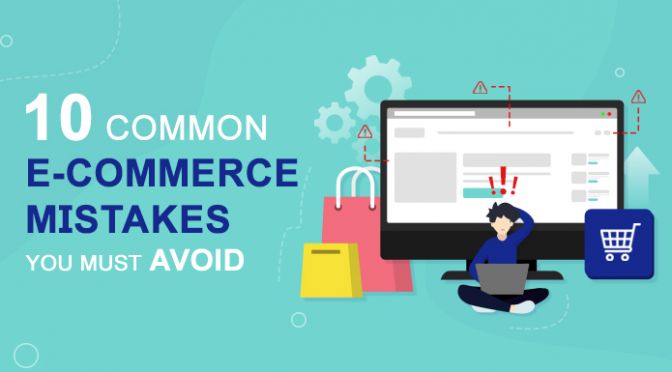In the fast-paced and competitive world of eCommerce, avoiding critical pitfalls can mean the difference between thriving and failing. Mistakes are inevitable, but some can be so costly that they drive customers away from your checkout page and directly into the arms of your competitors.
Whether you’re planning to launch an online store or already running one, understanding and addressing these common mistakes will set you on the path to success. Here are the top 10 eCommerce mistakes to avoid—and practical tips to fix them.
1. Using the Wrong Website Theme
Your website theme defines its look, feel, and functionality. A poorly chosen theme can confuse visitors and misrepresent your brand, costing you credibility and sales.
How to Avoid It:
- Clearly define the type of website you need before selecting a theme.
- Choose a responsive theme that adapts to different devices and screen sizes.
- Look for customization options to help your site stand out from competitors.
Pro Tip: Don’t rely solely on templates. Adding unique branding elements will help create a memorable shopping experience.
2. Insufficient Product Descriptions
Images alone can’t convey all the information your customers need. Vague or minimal descriptions leave room for confusion and can lead to dissatisfaction and returns.
How to Avoid It:
- Write detailed descriptions that include size, material, texture, and functionality.
- Address customer questions proactively: How is the product made? Does it come with a warranty?
- Use bullet points for easy readability and include usage instructions or care tips.
Pro Tip: Descriptions should not only inform but also persuade. Highlight benefits and unique selling points.
3. Low-Quality Product Images
Online shopping removes the tactile experience, so your images must compensate by being visually informative. Poor-quality or insufficient images deter purchases.
How to Avoid It:
- Use high-resolution images with zoom capabilities.
- Include multiple angles and color variations.
- Show the product in use to help customers visualize its functionality.
Pro Tip: Invest in professional photography or editing tools to showcase your products in the best light.
4. Complicated Checkout Processes
A cumbersome checkout process is a top reason for cart abandonment. Customers want convenience, not frustration.
How to Avoid It:
- Minimize steps in the checkout process.
- Allow guest checkouts—don’t force account creation.
- Make shipping costs and total prices clear upfront.
Pro Tip: Aim for a one-page checkout process to streamline the experience and increase conversions.
5. Limited Payment Options
Not offering a variety of payment options can drive customers away. Modern shoppers expect flexibility in how they pay.
How to Avoid It:
- Offer popular payment methods such as credit cards, PayPal, mobile wallets, and Buy Now Pay Later (BNPL) options.
- Research your target audience’s preferred payment methods and implement them.
Pro Tip: Security matters. Display trust badges to reassure customers that their payment information is safe.
6. Lack of Shipping Options
Shipping flexibility is crucial. Customers have different preferences—some prioritize cost, others prioritize speed.
How to Avoid It:
- Provide multiple shipping options, including express, standard, and free shipping.
- Clearly display shipping costs and delivery timelines before checkout.
- Partner with reliable logistics providers to ensure timely deliveries.
Pro Tip: Free shipping, even with a minimum purchase requirement, can significantly boost conversions.
7. Hiding Return and Exchange Policies
A lack of transparency regarding returns can erode trust. Customers want to know what to expect if a product doesn’t meet their needs.
How to Avoid It:
- Clearly outline your return and exchange policies on your website.
- Make the process simple and customer-friendly.
- Offer refunds or exchanges promptly to maintain goodwill.
Pro Tip: Visible and fair policies build trust and can even encourage hesitant customers to make a purchase.
8. Ignoring Customer Reviews
Customer reviews provide social proof and influence buying decisions. Ignoring or failing to collect reviews can hurt your credibility.
How to Avoid It:
- Encourage reviews by sending follow-up emails after purchases.
- Offer small incentives, like discounts, for honest feedback.
- Display reviews prominently on your product pages.
Pro Tip: Address negative reviews professionally to show you value customer feedback.
9. Poor Customer Service
Exceptional customer service is key to building long-term relationships. Slow responses or unresolved complaints can harm your reputation.
How to Avoid It:
- Offer multiple support channels, such as live chat, email, and phone.
- Respond to inquiries promptly and with empathy.
- Train your team to handle complaints effectively.
Pro Tip: Use chatbots for instant responses to common queries, but ensure human support is readily available for complex issues.
10. Neglecting Mobile Optimization
With the majority of online shoppers using mobile devices, a non-optimized site can drive potential customers away.
How to Avoid It:
- Use a responsive design that adapts to all screen sizes.
- Test your site’s speed and functionality on mobile devices.
- Simplify navigation for smaller screens.
Pro Tip: Mobile-first design is no longer optional—it’s essential for staying competitive.
How to Fix These Mistakes and Grow Your eCommerce Business
Running an eCommerce site requires constant optimization and attention to detail. By addressing these common pitfalls, you can create a seamless shopping experience that attracts customers and keeps them coming back.
- Regularly audit your website to identify weak points.
- Stay updated on industry trends and customer expectations.
- Prioritize user experience (UX) to differentiate yourself from competitors.
Mistakes are inevitable, but learning from them and making proactive changes can turn your eCommerce store into a thriving success. Start fixing these issues today, and watch your sales and customer satisfaction grow exponentially!
